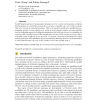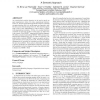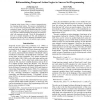169 search results - page 16 / 34 » Adding Structure to Agent Programming Languages |
ICLP
2011
Springer
13 years 3 days ago
2011
Springer
Parallel implementations of programming languages need to control synchronization overheads. Synchronization is essential for ensuring the correctness of parallel code, yet it add...
ATAL
2010
Springer
13 years 9 months ago
2010
Springer
An organizational modeling language can be used to specify an agent organization in terms of its roles, organizational structure, norms, etc. Such an organizational specification ...
POPL
2010
ACM
14 years 6 months ago
2010
ACM
We present a verified compiler to an idealized assembly language from a small, untyped functional language with mutable references and exceptions. The compiler is programmed in th...
APAL
2006
13 years 8 months ago
2006
This paper studies the complexity of behavior of multi-agent systems. Behavior properties are formulated using classical temporal logic languages and are checked with respect to t...
AAAI
2012
11 years 11 months ago
2012
Temporal Action Logics (TAL) is a class of temporal logics for reasoning about actions. We present a reformulation of TAL in Answer Set Programming (ASP), and discuss some synergi...



